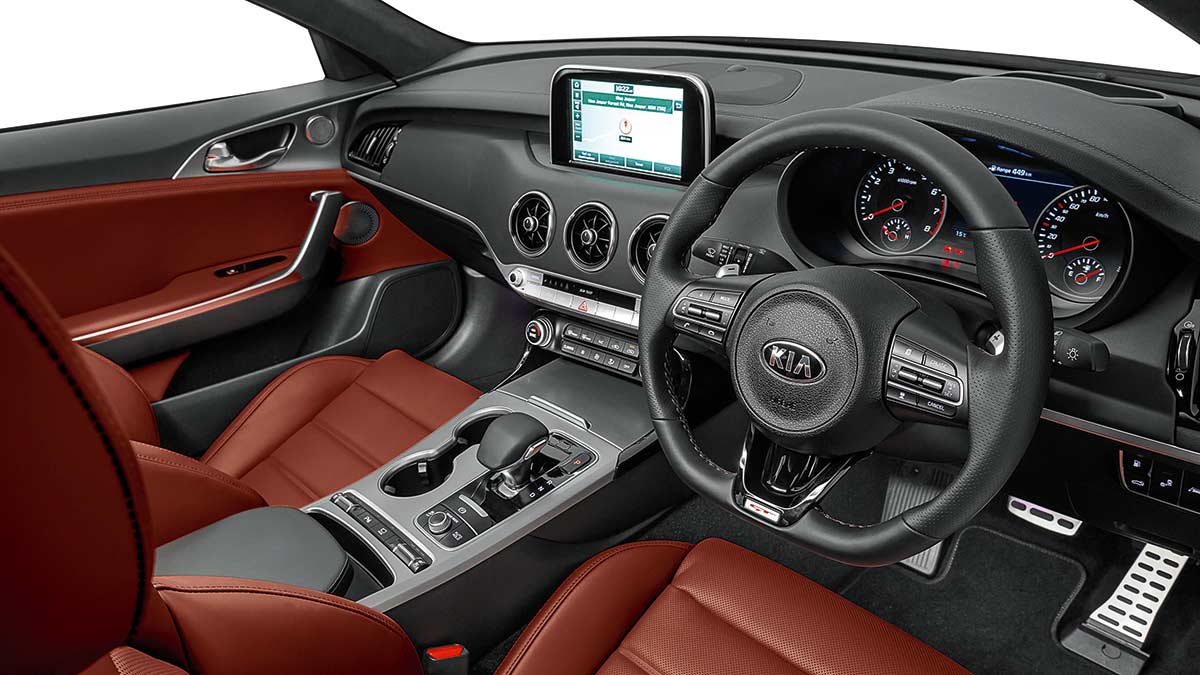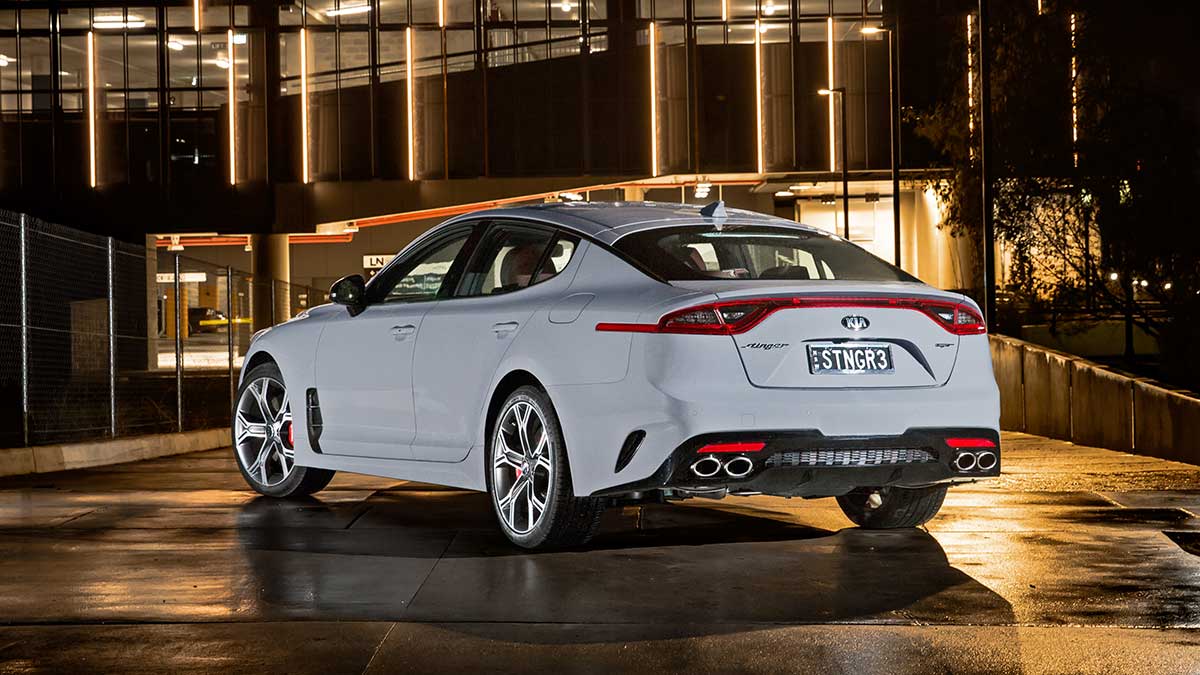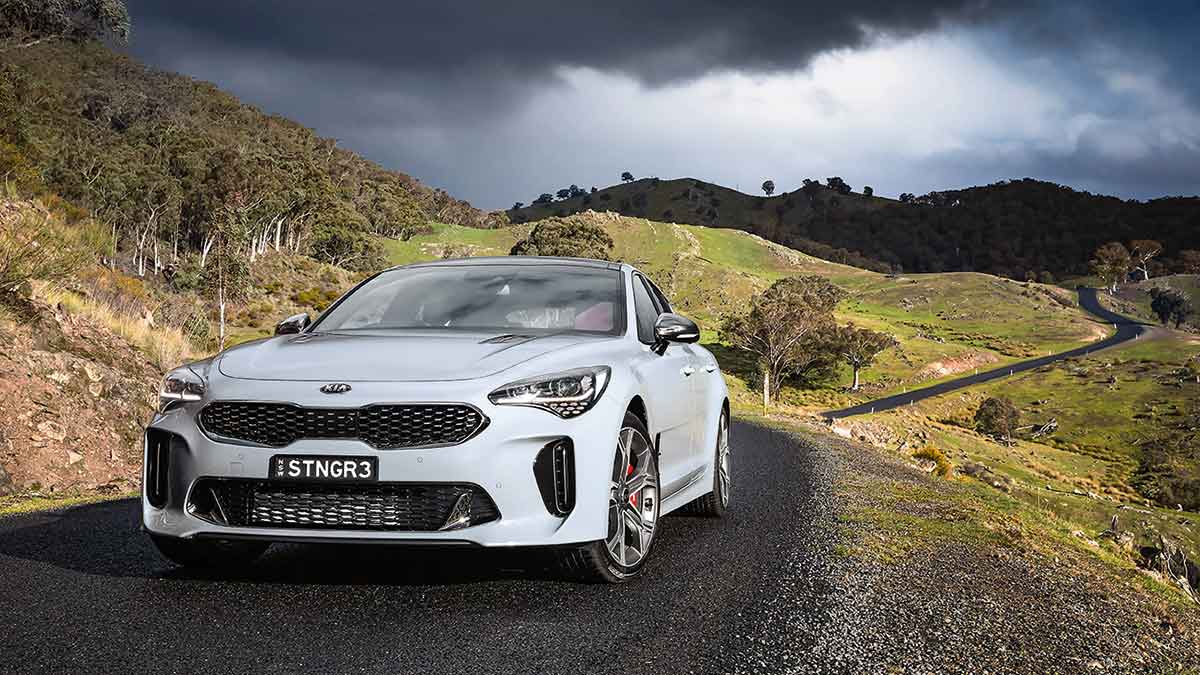The Foton Tunland joins Australia's dual-cab ute market as an affordable mild-hybrid diesel under $50,000, offering strong capability against tough competition.
Kia Stinger 330 GT review
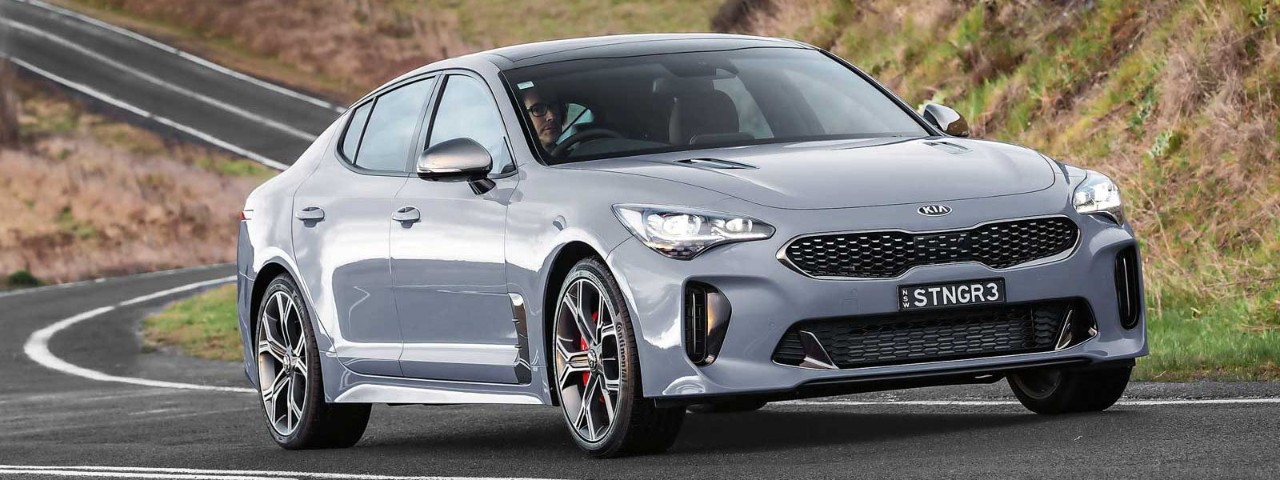
RACV tests the Stinger, Kia's large rear-wheel-drive sedan.
Kia is testing the large four-door sedan market with its stylish Kia Stinger, a vehicle primed to pick up sales from Commodore and Falcon, now that local production of these two stalwarts has ceased, by using its rear-wheel-drive configuration as the emotive hook. Yet the long, low, sweeping body architecture of the Kia Stinger, and its smartly crafted internal cabin presentation, position it more in keeping with prestige European brands.
Kia Stinger price
Pricewise it sits between the two. The Kia Stinger price of $45,990 plus on-road costs (for an entry-level 2.0-litre 200S) is essentially line-ball with the outgoing Commodore SV6. The price of V6 Kia Stingers ranges from $48,990 to $59,990, clearly putting it in contention with entry-level European marques. A comprehensively equipped, top-end Kia Stinger GT V6 is better value than a 2.0-litre Lexus or Infiniti, and the combination of style and performance is more appealing. Smart design, high build quality and engaging driver dynamics are compelling features of all Kia Stinger cars, regardless of whether it’s the agile turbo four-cylinder or the high-performance twin-turbo six. Add Kia Motors’ standard seven-year warranty, capped-price servicing and roadside assistance and the attraction grows.
Stinger engine
Stinger is a halo car for Kia, bringing more large-car style, driving engagement and performance than previously associated with the brand. Thus, Kia has been keen to use the GT (Grand Turismo) tag in its marketing, underlining Stinger’s comfort and performance ease for long-distance touring. And it lives up to the fanfare, delivering attributes long admired in locally developed big sedans, although with more individuality.
There’s a choice of two petrol engines, a single-turbo 2.0-litre producing 182kW and 353Nm, or a twin-turbo 3.3-litre V6 which pumps out an impressive 272kW and 510Nm. To put that into perspective, the outgoing Commodore SV6 delivered 210kW and 350Nm from its 3.8-litre V6. Each engine is available in three equipment levels — S, Si and GT — and all come with a silky eight-speed automatic transmission developed in-house at Kia.
Safety features
All Kia Stinger models have similar high-quality design, presentation and finish, and it’s essentially additional equipment that separates the higher Kia Stinger Si and GT versions. Its safety package has seven airbags, including a driver’s knee bag, an active pedestrian-protecting hood, rear-view camera, hill-start assist and ISOFIX child-seat anchorages along with mandatory ABS and ESC as standard.
Stepping up, the Si gains autonomous emergency braking, adaptive cruise control, forward-collision braking, lane-keep assistance, driver-attention alert, front parking sensors and rain-sensing wipers. Si models also include an eight-inch touch screen, a nine-speaker sound system, leather-appointed seats and rain-sensing wipers, with prices from $52,990 for the 200Si and $55,990 for the 330Si. V6 Si buyers also get 19-inch alloy wheels and Brembo performance brakes. Top-spec GT models add a 360-degree camera view, blind-spot detection, dynamic bending lights, high-beam assist and a colour head-up display.
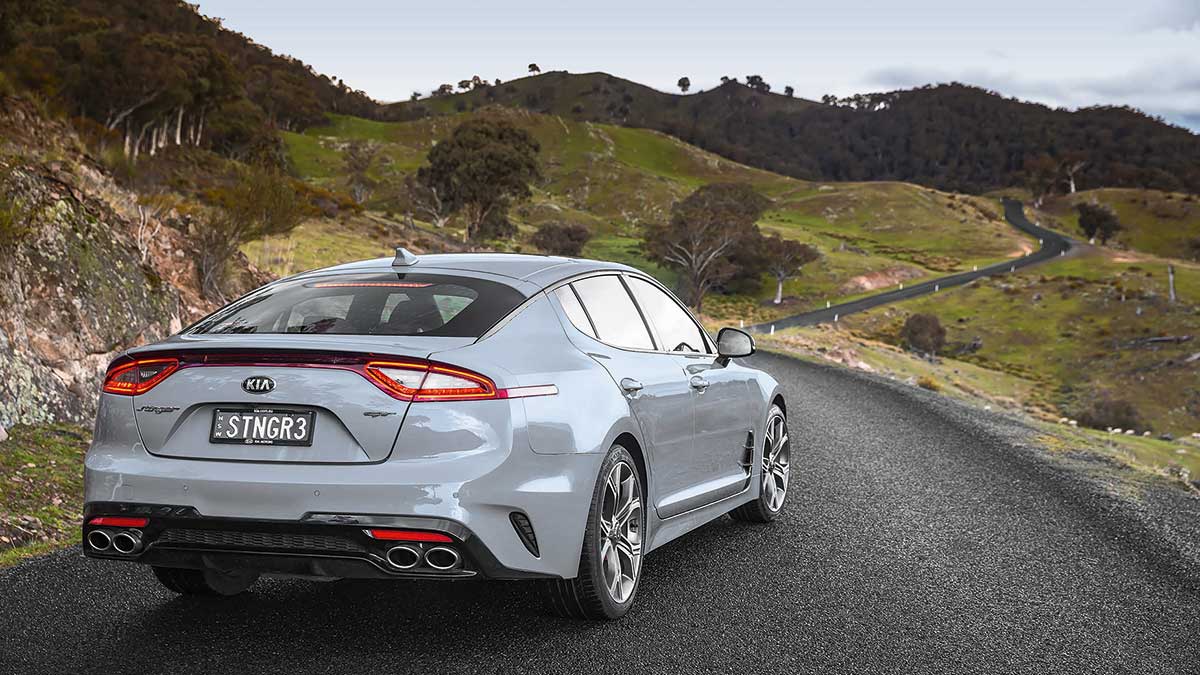
How does it drive?
The GT-Line (the 200 GT) starts from $55,990, and the 330 GT is from $59,900. Appealing features such as the eight-way powered driver’s seat can be found in all models, while our top-end GT comes with a comprehensive equipment list, including a matching powered passenger seat, heated and cooled front seats, leather trim, seven-inch colour instrument cluster, wireless phone charging, a 15-speaker premium Harman/Kardon sound system and a powered sunroof.
From our experience at Stinger’s launch, the 2.0-litre models impressed with their combination of performance and agility. It’s a notably well-balanced and dynamic car with similar torque to the superseded Commodore V6. That said, the effortless performance delivery of Stinger’s V6 was a standout. Outright acceleration easily matches traditional V8s, while equally impressive is the strong, V8-matching mid-range torque, which meant a smooth and flexible response in every situation.
Our average fuel consumption of 9.9L/100km is impressive given the performance, and both engines run on 91-RON fuel. Enthusiasts typically favour a traditional rear-wheel-drive configuration, and the Stinger is aided by a full suite of electronic controls which ensure maximum traction and stunning acceleration, as seen in our performance figures. Despite the power and rear-wheel-drive platform, it has a modest 1500kg towing capacity, with a ball load of just 75kg.
In keeping with other Kia auto models, Stinger has had the benefit of local suspension tuning, effectively targeting ride and handling control over a mixture of our less-than-perfect back roads at highway speeds. Low-profile tyres on the GT’s 19-inch wheels are prone to delivering a short, sharp thump over bumps around town, but once Stinger is flowing, the comfort, the body control and the feel of the electric power steering are excellent.
Stinger’s eye-catching design is derived from the long 2905mm wheelbase, wide stance and a notably low roofline and seating position, all of which affect some aspect of what should be a large and accommodating four-door hatchback. Its overall length of close to five metres can be an issue in some parking spots, ducking your head is a requirement when getting in, particularly in the rear, and the low seating will be awkward for many.
Interior
Once inside, the seating is snug and comfortable. Drivers will enjoy the tactile wrap-around cockpit, the smart, functional layout, and controls and instrumentation that are easy to identify and use. Driver vision is better than expected and aided by multiple cameras, while the GT also provides a head-up display. But the large centre console restricts width up front and limits seating in the centre rear, in effect making Stinger a good four-seater, with exceptional front and rear legroom, rather than matching the overall space of a typical mid-size sedan. The sunroof in the GT also forces the seating position lower, and the tapering roof line limits rear headspace.
There is, however, a modest limousine feel for rear-seat passengers, stretched out with a large centre armrest, air vents and access to USB/AUX sockets. The sloping rear glass and self-powered tailgate reduce boot space, notably for square boxes and the like, yet overall there is a reasonable load capacity for multiple smaller bags and a 60/40 split-fold rear seat for long items. The boot is well lit, there’s a temporary-use spare wheel under a solid flat floor and the Stinger has ISOFIX child-seat mounts along with top tether points on the seat back. Overall cabin fit and finish is first class.
The verdict
Stinger’s sweeping body style and nicely crafted cabin wrap well-engineered driveline and suspension components that underpin this engaging high-performance grand tourer.
The 2.0-litre model is a gem of balance and refinement, but it’s the V6 that truly steps up in the performance stakes, with comprehensively equipped high-end models delivering the best value for money.
These comments are from RACV’s experienced team of vehicle testers.
|
Price |
Kia Stinger 330 GT price: $59,990 + $5301 (est) ORC. Premium paint $695. Model range $45,990-$59,990. |
|---|---|
|
Safety |
ESC. 7 airbags. Auto emergency braking. Adaptive cruise control. Blind-spot, lane-keep, rear cross- traffic systems. Reversing and 360˚ cameras. Driver fatigue warning. Front/rear parking sensors. Auto lights/wipers. |
|
Connectivity |
8” touch screen. Sat-nav. Bluetooth. Premium audio. USB/AUX ports. Digital radio. Apple CarPlay, Android Auto. |
|
Vehicle and driver features |
Vehicle: Two-zone climate control. Leather-accented trim. Heated/cooled front seats. Sunroof. Driver: Head-up display. Drive modes. Eight-way powered seats with memory. Keyless entry/start. Auto-folding side mirrors. |
|
Specifications |
Drivetrain: 3342cc V6 twin-turbo petrol engine. Rear-wheel drive. 8spd auto. 272kW@6000rpm, 510Nm@1300rpm. |
|
Category ratings |
Pricing ✩✩✩ |
|
Service/repairs |
12-month/20,000km capped-price services. |
